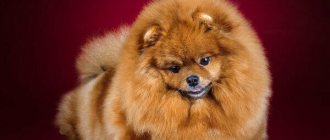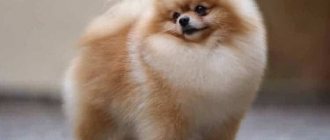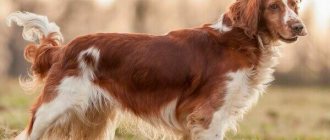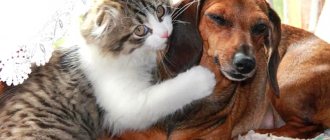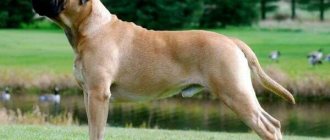The Medium (Klein Poodles) or by international standards the Small Poodle is the most popular variety of Poodle.
In addition to this, the varieties of the breed include large or royal (Standard Poodles), dwarf, Teacup Poodles, miniature Poodles, and Toy Poodles.
Pets get along well with children and other pets.
They are affectionate, kind and have a unique character.
Origin story and what it looks like in the photo
Images of a curly dog, very similar to a modern poodle, are found on ancient frescoes, Greek and Roman coins.
Initially, the breed was formed as a hunting breed, but in the 19th century, the medium poodle was increasingly used as a decorative lap dog and companion dog..
Among the ancestors of the poodle are barbets, Portuguese water dogs, truffle dogs, pointers, greyhounds, spaniels, retrievers, and Maltese.
Interesting Facts
Interesting facts about the breed:
- In Goethe's philosophical drama Faust, Mephistopheles appeared in the guise of a black poodle. It is known that the author himself was not a fan of these dogs and was even afraid of them.
- For a long time Beethoven could not come to terms with the death of his poodle. This forced him to create “Elegy” in honor of his favorite. The breed is also mentioned in the works of Tarber, Seewald, and Heine.
- In the 14th–16th centuries, this breed served as the so-called “weapon” of Spanish men. Due to the ban on dueling, they trained dogs to mark the house of their ill-wishers. Such entertainment was appreciated by brave young men, and puppies of this breed began to be called “tailed challenge.”
Description of the breed
There are several breed standards - German, English, American and French.
The French standard is adopted as the basis for the FCI standard used in Russia..
The latest edition of the official FCI standard came into force in 2015. All standards are the same for all varieties of the breed and differ only in size characteristics.
Main characteristics of the breed according to FCI:
- Group, purpose, test - 9. Companion dogs without tests.
- The general impression is that of a slender, harmoniously built, elegant dog with a sense of self-esteem. The proportions are average.
- The head is light, but without excessive refinement, refined lines, and is proportional in size to the body.
- The skull is slightly elongated, oval in shape.
- The forehead is rounded, with a longitudinal dividing groove, slightly narrowing from the ears to the muzzle.
- The muzzle is slightly shorter than the skull with a rectangular, non-pointed facial part.
- The nose is large with a flat back, rounded wide and open nostrils. The lobe is dark, depending on the color, from light chocolate to black.
- The eyes are almond-shaped, expressive, intelligent, slightly slanted. Dark brown or black.
- Ears with rounded ends, hanging down to the point where the lips close.
- The lips are dry, of medium width, adjacent to the jaw. The upper lip hangs over the lower lip.
- Scissor bite.
- The teeth are strong and white.
- The length of the neck is almost equal to the length of the head. The neck is strong, with a clearly visible bend, without folds. The head position is high.
- The body is slightly elongated and strong.
- The back is wide, short, straight.
- The chest is wide, deep to the elbows, the keel bone protrudes slightly beyond the line of the torso. The ribs are oval.
- The loin is strong and muscular.
- The croup is rounded, but not sloping.
- The groin is toned, but without “undermining”.
- The tail is set high, carried high and slightly slanted. The tail is left natural, but can be docked by half or a third.
- The limbs are straight, developed, flexible, parallel, with strong joints.
- The foot is not large, but strong.
- The fingers are curved, compactly collected, and webbed. Dewclaws are removed. The claws are dark brown or black.
- The coat is thick, elastic, without a specific odor, curly or corded.
- Movements are free, graceful, springy.
The name "poodle" comes from the German "pudeln" - to splash in the water, which indicates the original hunting purpose of the breed.
PUPPING
Pupping, as a rule, is not unexpected.
Usually, some signs appear that can be considered as harbingers of childbirth - a sagging belly, refusal to feed, etc., but above all - anxiety: the dog tears up the bedding, prepares a “nest” for itself, changes places, whines, hides in dark corners, often seeks help from the owner. In addition, before childbirth the following phenomena are observed: the external genitalia swell and mucus is released from them. The size of the nipples and mammary glands increases, and colostrum appears. But some dogs produce colostrum later, sometimes during or immediately after birth. At the first signs of labor, it is necessary to wash the external genitalia, abdomen, perineum, inner thighs with warm water and toilet soap and wipe dry. The birthing area must be provided with clean bedding, and it must be of such size that the dog can stretch out while lying on its side. During birth, bedding must be changed, ensuring that the dog and newborns are dry at all times. For childbirth, you should prepare a “birth kit”: a set of clean gauze napkins, cloth napkins, 5% iodine tincture, boiled linen threads, scissors. Have hot water on hand if you need to revive a puppy with breathing problems. You shouldn't be afraid of childbirth. They usually proceed without serious complications. Contractions (periodically repeated wave-like contractions of the uterine muscles) are the main force of labor. During contractions, the uterus opens and the fetus is further expelled. The children's place is also displayed. At the beginning of labor, uterine contractions are not so noticeable, but later they gradually intensify and soon become maximum in strength. Then the muscles of the uterus relax, and there is a pause. During one of the contractions, light amniotic fluid is released. This is fine. The second period is the actual birth, pushing. Pushing is a contraction of the muscles of the uterus with simultaneous rhythmic contraction of the muscles of the abdominal wall and diaphragm. Attempts in a dog appear after the uterus dilates and occur reflexively. Within certain limits, they can be enhanced or restrained by the dog itself. Thus, efforts that increase intraperitoneal pressure and contractions create conditions for the fetus to come out. During a normal birth, the dog's assistance is limited to monitoring the birth and delivering the newborns. The reception of a newborn is as follows. Immediately after birth, the puppy’s mouth and nose must be cleared of mucus and amniotic fluid by inserting a gauze swab into the puppy’s mouth and immediately pulling it out. Mucus and amniotic fluid that enters the puppy’s mouth are quickly absorbed into dry gauze and do not cause further complications. After treating the oral cavity, the umbilical cord and wiping the puppy dry, give it to the mother, who will lick it, then place the newborn on the nipple and, if necessary, help him take the nipple, i.e. spreading the fur around the nipple, lightly press on it until colostrum appears and place the puppy’s lips on the nipple. You should also make sure that the dog does not crush the cubs near it during subsequent contractions. For a while, they can be moved to the side or placed in some clean box on a litter with a heating pad placed under it. The puppies should not be taken away; the mother should see them and be calm for them. The puppy may walk head or rear first, which does not matter if the bladder and umbilical cord are intact. If the puppy walks backwards, you need to help him get out, otherwise he may choke. At the moment when the bitch is pushing, you need to take with your hand what is sticking out and pull it out and down. The bitch herself opens the amniotic sac and bites the umbilical cord, separating it from the placenta. If the umbilical cord is long and the placenta does not come out after the puppy, then after biting it remains in the birth canal and should come out before the next puppy.
Character traits
The character of medium poodles is unique.
Dogs:
- smart, curious;
- active, playful, love to participate in exhibitions, receptive to praise;
- affectionate, sociable, feel the owner;
- efficient, hardy, passionate.
The author of the book “Dog Intelligence”, Dr. Stanley Coren, gave poodles second place in intelligence and trainability after the border collie.
Expert opinion
Kozhevin Semyon Kirillovich
Expert dog handler.
The medium (small) poodle is a small, curly-haired miracle, energetic and graceful, able and loving to enter the ring. These are dogs with a stable psyche and a pronounced show temperament. They have self-esteem and are not cowardly. Not prone to empty talk.
Poodle training
A smart breed, the poodle picks up everything on the fly.
But he can use his ingenuity to gain the opportunity to disobey. A curly-haired sly man will always try to take advantage. The puppy should be taught order right away. The cute antics of a baby can turn into a problem for an adult dog. Therefore, you need to stop your pet’s unwanted actions. From an early age, the dog is supposed to be calm about the procedures, dental examination, combing, and bathing.
Having accustomed the poodle to its nickname, you need to use commands that ensure the dog’s safety: “to me”, “nearby”. Training is carried out in a playful way, and if the command is executed correctly, praise is given. Violence is not the best choice of training; if punishment is unavoidable, it is worth reprimanding the prankster in a stern voice.
Even a child can train a poodle if the following rules are followed:
- The owner gets food first;
- the dog is the last to go through the door;
- the pet sleeps only on its own bedding;
- the master's chair is inviolable;
- Begging is unacceptable.
For some, the actions may seem insignificant, but for the dog these are signs that determine its position in the pack.
Advantages and disadvantages
Owners believe that dogs are full of virtues:
- obedient, understanding;
- artistic, talented, capable of imitation;
- universal in use (companion dogs, entertainers, guide dogs, orderlies, therapy dogs, athletes, search dogs);
- compact, easy to travel;
- They are not aggressive, but do an excellent job as a watchman.
The disadvantages of medium poodles include::
- tendency to dominate, stubbornness;
- difficulty in caring for hair;
- tendency to hereditary diseases and food allergies;
- unbearable loneliness;
- requirement of full physical activity.
Historical reference
The average Poodle is an exclusive of the modern world, because neither selection, nor exhibitions, nor forced transformation into a decorative dog have harmed the dog’s intelligence and abilities. Wherever these curly-haired warriors were noted, they helped in the hunt, participated in military operations, shone in the rings and sports fields... they are unique and inimitable and this must be given due credit.
This is interesting! A monument to the fearless black Poodle named Mustache was erected in the province of Badajoz (Spain). The quadruped fought bravely in Napoleon's army, was officially included in the regiment's list and was awarded a medal for bravery. This dog fearlessly rushed into battle more than once, saved two-legged comrades and once saved the entire regiment by raising the alarm in time.
There are many gaps in the history of the breed, but only one thing is known for certain: the average standard Poodle and its brothers have always occupied leading places in the “top of popularity.” Where did this breed come from? The question is complex, judge for yourself:
- Very similar curly-haired quadrupeds are depicted on the frescoes of ancient Greece.
- Closer to the 15th century, Poodles also lived in France , this is confirmed by images of dogs in paintings and in the literature of those times.
- Since the 16th century, curly hair has spread to England and surrounding countries.
- By the 17th century, the Poodle had conquered Germany and the hearts of famous artists.
- Since the beginning of the 18th century, dogs were widely used in military affairs and there is a lot of evidence for this. Poodles served as signalmen and orderlies (carrying the wounded out of the battlefield).
- In the 19th and 20th centuries, quadrupeds became famous throughout the world. Soldiers returning home took the dogs home. Military personnel, especially those injured, rarely received any subsidies. Poodles often helped their owners earn a crust of bread by performing tricks and tricks for onlookers. Further, the career of the tailed animals continued in circuses and various shows.
This is interesting! Hunting with a Poodle is still practiced today! In the middle of the 20th century, a club was founded in France where working tests of Poodles and Retrievers were carried out.
Few people know that the extravagant haircuts of Poodles are not a tribute to fashion, but a means to increase stamina. Four-legged animals love water very much and simply cannot deny themselves the pleasure of offering aport. This allowed the use of dogs in duck hunting . The Poodle combined all the features inherent in a gun dog, but the cords of long hair made it difficult to get through bushes and reeds. The hunters found a way out - they cut off the four-legged animal, leaving hair on the chest, body and “cuffs” of the paws. Thus, the coat protected the lung area and preserved the dog's endurance against the backdrop of its agility in water.
This is interesting! An unexpected fact about the tradition of collecting “tails” on the tops of Poodles’ heads. There was no need to trim the hair from the dog's head, but the curls falling over the eyes impaired the view. By tying his ponytail with a colored ribbon, the hunter not only increased the performance of his ward, but could also identify him from afar.
The Poodle dog breed has been “appropriated” to other countries more than once, by mistake and intentionally. For example, at a time when Poodles were actively used for duck hunting, the breed was “named” Spanish (1902). This was due to two circumstances: the spread of curly, large, bearded dogs in Spain and the mention of the breed in early literature. Similar to the case described above, the origin of the breed was assigned to Germany, England, Hungary, and each time, the “speakers” pulled out trump cards from their sleeves, making their version plausible.
This is interesting! The hunting skills of Poodles were so highly regarded that the dogs served as the gene pool for a new breed. To obtain more versatile gun hunters, breeders mixed the blood of “curly” and Pointers. Today, the Poodle Pointer is considered a successfully created English pointing dog breed.
The Poodle began to be considered as a companion at the end of the 19th century. The reason for the wide “apartment distribution” was the characteristics of the breed, which were voiced by the respected dog handler Paul Shaitlin. The description included many epithets, in short - universal, talented, phenomenally smart, adaptable to any climate, imitative, with artistic abilities, easily learning commands and tricks.
Color variations
The latest version of the standard describes 6 acceptable color variations of the breed:
- Black.
- White.
- Warm brown, dark brown. Undesirable variations: beige, light brown with a golden tint, chocolate, faded red.
- Gray (silver). The color should not be close to black or white.
- Apricot. It should be pure apricot, not bleached red or brown.
- Red (red). Shades of fawn, orange and red are possible.
Some national (Russia, Great Britain, Germany, Czech Republic, USA) breed standards recognize the colors harlequin and black and tan.
The color should be one color and uniform, without spots, marks, or overflows.
There are several colors not recognized by the standard:
- harlequin - black and white;
- brindle - a striped pattern on a background of any color;
- black and tan - black with markings of any shade;
- sable (burnt dough color) - dark brown topcoat with black or dark brown tips;
- silver beige - dogs are distinguished by amber eyes;
- coffee with milk - a combination of chocolate, apricot and cream;
- cream - shades of champagne color;
- blue and blue - gray (silver) with a blue tint;
- splash - white spots on any background, occupying less than 50% of the total body area;
- merle (marble) - light or dark inclusions on any background;
- two-color - spots are chaotically located on a white background, often black or brown.
Puppy cost
The price of a poodle puppy depends on its size variety, origin, color, quality and exhibition prospects in the future. The most expensive currently are toy poodles, the price of which can be 50-65 thousand. Puppies of rare or more valuable colors that look most advantageous in the show ring, for example, apricot or white, will also cost more.
A pet-class poodle puppy can be purchased for 15-20 thousand, and kids with show potential, on the contrary, will cost more than ordinary representatives of this breed.
On average, the cost of a poodle puppy of any size variety is 25-35 thousand rubles.
Attitude towards children and pets
The average poodle can safely be called a children's friend. He is easy-going and enjoys taking part in children's pranks.
He perceives strangers with caution, but, seeing the owner’s positive reaction, he can include guests in the “inner circle” of communication..
He strives to establish friendly relations with pets.
Application
Poodles once served successfully as hunting dogs. Today they have become mainly companions for glamorous ladies and wonderful pets for people of different ages. Due to their keen intelligence and high trainability, these dogs are often used in circus performances and various shows.
The poodle can be a bodyguard, but this breed is not suitable for guarding the house.
An energetic and strong animal will become an excellent athlete, and you can practice freestyle or agility with him.
How to properly care
Regular treatments required:
- Combing 3 times a week. In puppyhood - daily.
- Bathing with zoo shampoo (no more than 4 times a year) or without it when soiled and before exhibitions.
- Haircut, plucking every 2 months.
- Inspect the ears after each exit to the street, clean them at least once every 14 days.
- Eye examination by a veterinarian at least 2 times a year, wiping - weekly.
- Arrangement of the bed in a place protected from drafts.
- Trimming of nails as they grow, pedicure before going to the arena.
PUPTY
After mating, the bitch requires special attention, since intrauterine development and the correct formation of the fetus are closely dependent on the state of the body of the expectant mother. The health of the future puppy can be negatively affected by an imbalance in the mother's food supply, the absence or deficiency of vitamins in the food, insufficient exercise of the pregnant bitch, as well as untreated wounds, worms, etc. If the feces of the dogs involved in mating have not been tested for worm eggs, then 10-15 days after mating the bitch should be given an anthelmintic medication. Giving your dog anthelmintic drugs after the thirtieth day of pregnancy is not recommended. Very serious attention should be paid to the walking of a pregnant dog: throughout pregnancy, she should walk at least two hours a day. From the day of mating until the end of the puppies' feeding period, the bitch is given calcium glycerophosphate, calcium gluconate or calcium phosphate (from 0.1 to 1 g per day) in her food. In the absence of mineral salts, it is necessary to give the dog meat and bone or fish and bone meal in the same doses. The pregnancy state lasts from 58 to 63 days. From the thirtieth day, the dog is carefully monitored, activities and games associated with sudden movements and significant stress are stopped. The dog owner is usually concerned about whether pregnancy has occurred. However, there are no reliable signs of pregnancy in a dog in the first four weeks after mating. The dog may be sad and lethargic, drink and eat a lot, or vice versa. In the fifth week after mating, her nipples swell, acquire a pale pinkish color, and colostrum begins to separate. Mucus discharge is observed from the vagina. By the sixth week, the belly increases, the dog begins to build a nest, but it is still impossible to say for sure that pregnancy has occurred. Clarity comes by seven to eight weeks, when it is already possible to feel the movement of the fetuses, which is a reliable sign of pregnancy. Owners of mated bitches should be fully aware of the need for constant contact with a veterinarian during both the preparation of the dog for mating and whelping. The doctor will not only observe the dog, but will also tell the inexperienced fan how to behave and what assistance to provide to the dog and puppies, if the need arises. During pregnancy, not only external changes are observed in the structure of the dog’s body, but also changes in metabolism occur. The endocrine glands begin to work intensively. The amount of blood increases - by 20-25% by the end of pregnancy. The explanation is simple: it is necessary to nourish the developing fruits and remove unnecessary metabolic products from them. The dog’s cardiovascular system works in accelerated mode: the pulse quickens and the number of respiratory movements increases. The process of gestation usually proceeds favorably if the dog is provided with good living conditions. The most important components of a dog's food are: proteins, fats, carbohydrates, minerals, water and vitamins.
How long do they live? Major diseases
Medium poodles live 12-15 years.
Long-lived individuals have been known to live up to 18 years. Dogs are prone to a number of breed-specific diseases that can significantly shorten their life expectancy.
Among them:
- lymphadenitis;
- diabetes;
- von Willebrand disease;
- urolithiasis disease;
- insulinoma;
- epilepsy;
- indigestion, volvulus, bloating of the peritoneum;
- congenital deafness;
- pelvic-femoral dysplasia, bone fragility;
- otitis;
- retinal degeneration, glaucoma;
- cryptorchidism;
- overgrowth of the nasal passage;
- tartar;
- hypothyroidism
Sizes and weights of adult poodles:
| Variety | Height at withers | Weight |
| Average | 35-45 cm | 9-12 kg |
| Big | 48-58 cm | 20-23 kg |
| Miniature | 28-35 cm | 6-8 kg |
| Miniature, toy poodle | 25-28 cm | 4.5-5 kg |
The growth of a medium poodle puppy ends at 12 months.
Searching for a spouse.
The search for a partner for a bitch should begin after a conversation with the breeder. Maybe he will not only advise which manufacturer to choose, but also give the address and telephone number of its owner. You need to look for a spouse for your bitch among the males who already have show grades and permission to breed. If you are not sure about the right choice, seek help from the club’s dog handler and, of course, your breeder. A female dog's heat lasts approximately 21 days. As a rule, fertile days (when there are the most mature eggs) occur on days 11-13 of estrus. Although there are significant individual deviations - from 8 to 21 days! A bitch in heat should be protected from accidental matings. When walking, don’t let even your Obedience Champion off the leash. The instinct to procreate is the strongest. What to give a poodle? How and what to feed a poodle puppy and an adult pet? When talking about dog nutrition, many owners immediately decide that the main food is meat. However, only meat feeding can kill a dog. From the very first days, a reasonable owner will establish a balanced diet, including a sufficient amount of proteins, fats, vitamins for dogs, minerals and trace elements. A poodle's diet should consist of animal and plant foods containing all the substances necessary for the body.
It has been established that to ensure the normal functioning of a dog’s body, 1 kg of body weight per day requires: proteins 4-5 g, fats - 1-2, carbohydrates - 12-15, mineral salts - 8-10 g; vitamins: A – 1-5 mg, B1 – 0.5, C – 10, B2 – 2-3, PP – 10 mg.
Nutritional features. What is better and how to feed it correctly?
To feed a medium poodle, use ready-made food (preferably marked “For poodles” or “For dogs of medium breeds”), corresponding to the age of the dog and its lifestyle, premium or super premium class.
You can create a dog menu that also includes natural products.
It should include:
- raw or boiled lean meat (veal or beef);
- beef by-products;
- raw beef and veal bones;
- raw chicken eggs;
- fermented milk products without flavoring additives;
- rice and buckwheat porridge, cooked in broth or water;
- seaweed;
- raw and cooked seasonal vegetables and fruits;
- dried fruits, raisins.
Strictly prohibited:
- fatty meats;
- sweets, baked goods;
- herbs and spices;
- food that is too hot or cold;
- pickles, smoked meats;
- raw sea or river fish;
- sausages, brisket, lard.
NOTE!
The diet of each dog is compiled individually, based on its preferences, lifestyle and health status.
Puppies up to 2 months of age are fed 5-6 times a day. From 2 to 4 months - 5 times, from 4 to 7 - 3-4 times. At the age of 10 months, babies are transferred to an adult feeding regimen - 2-3 times a day.
Care
The advantage of a poodle is its coat. To keep your dog clean, you need to cut it monthly, bathe it weekly, and brush it every 1-2 days using special combs. Despite the fact that the poodle's coat sheds lightly, by brushing the dog, you get rid of dirt and the formation of possible tangles.
To maintain the beauty of the animal's coat and health, feed it with dry and wet food specifically designed for this breed. In addition, it is necessary to monitor portion sizes and feeding regimen - poodles are at risk of obesity.
Experts recommend carefully caring for your pet’s teeth - this breed is characterized by the development of oral diseases: gingivitis and stomatitis. Soft plaque is best removed with hard treats.
Don't forget to care for your poodle's ears and eyes. Inspect and wash them weekly. The fur around the ears can be trimmed a little.
Hurry up, choose a box and find out what gift awaits you
Discount on pet insurance
Promo code copied to clipboard
Types of haircuts
Only dogs with show haircuts are allowed into the ring.
There are several of them:
- English haircut . The back is trimmed to the line of the ribs, the croup, the front legs and the muzzle; round or oval pompoms, bracelets or constrictions are left on the tail and joints. The bangs are pinned up.
- A lion. The haircut is similar to the English one, but “pants” can be left on the front legs.
- Modern. Only the paws and muzzle are trimmed.
The appendix to the FCI standard describes another, conditionally acceptable haircut, as a preparatory stage for permitted haircuts - papi.
Hunting
Even if this is unexpected, you should not leave the working qualities of the breed behind the scenes. If you live in the city and decide to get a Poodle, you will be shocked by the behavior of your ward in nature. Guided by instincts, the curly will not bypass any river, lake or even puddle. Birds that dare to fly too low or perch on branches will also become targets of predilection. Within the city limits, the Poodle will definitely be interested in rodents, especially rats in multi-storey buildings. By the way, cats are safe next to curly cats; the hunting instinct mysteriously does not apply to them.
How to choose? Boy or girl?
Selection rules are standard:
- the nursery must have a good reputation;
- conditions for keeping puppies comply with standards;
- the puppy must have a full set of documents: pedigree, puppy passport with marks;
- A certificate of testing for genetic diseases is desirable;
- the puppy should look healthy, active, and moderately well-fed;
- The fur should be shiny, the eyes and ears should be clean, and there should be no discharge in the anal area.
Girls are considered more flexible and calm, boys are more active, energetic, and curious . But a dog's temperament sometimes manifests itself in a completely different way than expected.
Nicknames
A dog's nickname is chosen for its entire life. It should be sonorous, but at the same time simple, so that the animal can easily remember it.
| For boys | For girls |
| Henri | Adele |
| Athos | Anetta |
| Bruno | Valerie |
| Georges | Julie |
| Leon | Georgette |
| Marseilles | Katrina |
| Samson | Margot |
| Thierry | Nicole |
| Javier | Helen |
| Etienne | Ellie |



